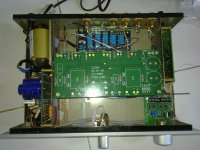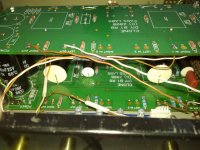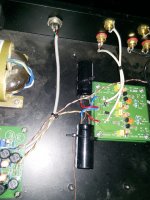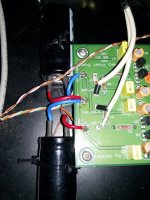Well my old faithful preamp of 18 years is being temporarily retired in order for some major upgrades. so I need a stop gap. With me stop gap probably means about 6 months.Based on what I had lying around in the parts bin a B1 seemed to be a very good starting point. Quick and easy and cheap to build (esp as I have a +/-15v supply lying around) and if nothing else would be better than the unit I am taking out of service.
when planning the build I started wondering about the age old question with line stages, over whether is it better to put the buffer before of after the pot. I realised that, as I have enough transistors for 4 buffers I could build something that, with a couple of extra switches would allow me to select from one of 4 options
Passive
Buffer before pot
buffer after pot
buffers before and after.
Which will allow me to test whether there is any difference and if I would have been OK with a passive line stage all along.
I have a 10K stepped attenuator on its way, mainly as I will need that for the other pre-amp rebuild, so will fit that initially. Once the stripdown of the old pre-amp is underway, then a 50k will become available. I could go really silly and have selectable pots to compare 10k and 50k in passive mode.
Will all the above answer any pressing objective questions...Nope, and I hope that subjectively I can't hear any difference between the 8 modes. But no harm will be done and I will at least know if the outputs of my source components have any limitations for my use cases
when planning the build I started wondering about the age old question with line stages, over whether is it better to put the buffer before of after the pot. I realised that, as I have enough transistors for 4 buffers I could build something that, with a couple of extra switches would allow me to select from one of 4 options
Passive
Buffer before pot
buffer after pot
buffers before and after.
Which will allow me to test whether there is any difference and if I would have been OK with a passive line stage all along.
I have a 10K stepped attenuator on its way, mainly as I will need that for the other pre-amp rebuild, so will fit that initially. Once the stripdown of the old pre-amp is underway, then a 50k will become available. I could go really silly and have selectable pots to compare 10k and 50k in passive mode.
Will all the above answer any pressing objective questions...Nope, and I hope that subjectively I can't hear any difference between the 8 modes. But no harm will be done and I will at least know if the outputs of my source components have any limitations for my use cases
In general a vol pot cannot drive the audio load that follows. This becomes a much bigger problem when higher value vol pot is used and/or it is used to drive some interconnect cabling.
Keeping to 10k for the vol pot and using <<1m of low capacitance cable may not require a buffer to maximise the audio signal that your want to pass.
Any more capacitance than suggested or more impedance and a buffer becomes mandatory.
A buffer before the vol pot is never required.
It's the Source that may or may not require a buffer to drive the interconnect cable and the paralleled vol pot load.
Source>Buffer>cable>vol pot>Buffer>cable>Amplifier.
This results in 4 Buffers to drive 4 cables in a stereo connection.
Keeping to 10k for the vol pot and using <<1m of low capacitance cable may not require a buffer to maximise the audio signal that your want to pass.
Any more capacitance than suggested or more impedance and a buffer becomes mandatory.
A buffer before the vol pot is never required.
It's the Source that may or may not require a buffer to drive the interconnect cable and the paralleled vol pot load.
Source>Buffer>cable>vol pot>Buffer>cable>Amplifier.
This results in 4 Buffers to drive 4 cables in a stereo connection.
In general no, but no harm in testing. And if the source cannot drive the cable and load, then a high input impedance is good. I hope to hear no difference with or without the input buffer. I also hope to discover that a fully passive mode is not as good. Whichever way I will learn something, if only that I am cloth eared and driven by preconceptions.
I quite liked my first attempt at a DIY passive pre (vol pot inside a little metal box).
I had just bought my Tannoy Berkleys (about 1978, the last of the HPDs before the factory got burnt down and they had to make new alloy casting moulds) which are reputed to have a quite strident Treble response.
At low volumes it all sound nice.
As I turned it up the treble became more rolled off. This probably resulted in a "too loud" filter being implemented to partially attenuate the strident treble.
Result: even at very loud, it still sounded nice.
As I learned more, I removed the passive pre.
I had just bought my Tannoy Berkleys (about 1978, the last of the HPDs before the factory got burnt down and they had to make new alloy casting moulds) which are reputed to have a quite strident Treble response.
At low volumes it all sound nice.
As I turned it up the treble became more rolled off. This probably resulted in a "too loud" filter being implemented to partially attenuate the strident treble.
Result: even at very loud, it still sounded nice.
As I learned more, I removed the passive pre.
Last edited:
I have build one
I am using one, double buffer Pass B1. I have stacked PCBs over each other.
B1 Buffer -> Volume Control -> B1 Buffer
It depends upon source whether to sound same or have improvement. Many of my friends happy without source side buffer.


Same with stacked DCB1. I found it get more details for phono stage and Tuner, but ineffective with my DAC.


I am using one, double buffer Pass B1. I have stacked PCBs over each other.
B1 Buffer -> Volume Control -> B1 Buffer
It depends upon source whether to sound same or have improvement. Many of my friends happy without source side buffer.


Same with stacked DCB1. I found it get more details for phono stage and Tuner, but ineffective with my DAC.


Last edited:
I think there is a message in there that you are not seeing.Same with stacked DCB1. I found it get more details for phono stage and Tuner,
A Buffer at the input should have absolutely no effect on the system performance.
The fact that you are hearing a change tells me that something is actually changing.
I would conclude that these two Sources are struggling to drive the combined load of the cables and the input impedance of the Receiver and the RF filter in the Receiver.
Taking that conclusion to what you did, we arrive at isolating the Receiver input impedance and the Receiver RF filter from the load that the Source has to drive, you have now got the Sources just driving the cable and a very high Rin without an RF filter.
This then tellls me that your two Sources are the problem.
Sort the sources and make them able to drive the Cables AND the Receiver AND the very necessary RF filter.
Move the Buffer to the output of the two Sources. Build two Buffers if that is what is needed.
Sort the problem, don't just plaster over the crack.
okay I forgot to add one thing. I have LDR based volume control which as impedance of ~13KΩ. I faced loss of LF and details HF. So people who are happy with only buffer after volume control are using volume control either 25KΩ or 47KΩ.
So you recommend extra buffers on everything? When raising input impedance in one place achieves the same. If raising input impedance is the cure why is that 'plastering over the crack'. In an ideal world all sources have vanishing small output impedance and good current draw and all receivers have very very high input impedances (at least in the single ended world).
Mind you, an active cable has certain audiophool pretentions and would impress visitors.
Mind you, an active cable has certain audiophool pretentions and would impress visitors.
A Buffer is a 1x gain amplifier with a high input impedance and a low output impedance.
Most Buffers are designed to perform a particular duty.
Line driving Buffers are probably the most common.
They are designed to drive line level signals into interconnect cable with a Receiver circuit at the far end.
They are so useful that literally dozens of designs are posted on this Forum.
Choose one to suit the duty.
When do you need a Buffer?
When the Source is incapable of driving the interconnect cable and the load on the far end of that cable.
Most Sources can drive short low capacitance cables, resulting in very few Sources needing a Buffer.
When a Buffer is needed, it should not be placed at the wrong end of the cable.
Sources are usually designed and manufacturered down to a price. That price shaving usually results in a just adequate current sourcing capability from a barely low source impedance.
When those two stack up together with cable capacitance, the Source proves to be not capable of sourcing sufficient current.
If all sources were designed to drive 50ohm transmission line from a source impedance of 50ohms or less then we would be in an ideal world.
That is not what exists.
Most Buffers are designed to perform a particular duty.
Line driving Buffers are probably the most common.
They are designed to drive line level signals into interconnect cable with a Receiver circuit at the far end.
They are so useful that literally dozens of designs are posted on this Forum.
Choose one to suit the duty.
When do you need a Buffer?
When the Source is incapable of driving the interconnect cable and the load on the far end of that cable.
Most Sources can drive short low capacitance cables, resulting in very few Sources needing a Buffer.
When a Buffer is needed, it should not be placed at the wrong end of the cable.
We are not in an ideal world.In an ideal world all sources have vanishing small output impedance and good current draw
Sources are usually designed and manufacturered down to a price. That price shaving usually results in a just adequate current sourcing capability from a barely low source impedance.
When those two stack up together with cable capacitance, the Source proves to be not capable of sourcing sufficient current.
If all sources were designed to drive 50ohm transmission line from a source impedance of 50ohms or less then we would be in an ideal world.
That is not what exists.
Last edited:
I think we will have to agree to disagree. My sources are fixed and not in line for replacement short term. My pre-amp is on its last legs and IS. I have control over that and the cables. If the source cannot drive the combined R and C presented, you suggest removing C from the equation and I am testing increasing R. Neither are invalid, but I have the parts to hand to build it the way I want to test and don't to build it the way you suggest.
I am hoping to find the input buffer to be surplus to requirements and will be happy if that is that case. If it isn't then I will have to decide if I need to prioritise other changes in the system.
I am hoping to find the input buffer to be surplus to requirements and will be happy if that is that case. If it isn't then I will have to decide if I need to prioritise other changes in the system.
it seems you did not notice this in my postI think we will have to agree to disagree. My sources are fixed and not in line for replacement short term................
Most Sources can drive short low capacitance cables, resulting in very few Sources needing a Buffer.
it seems you did not notice this in my post
Nope saw that. As I said in my first post I don't expect to hear any changes, but it's an interesting experiment for me and will prove if the new preamp I am building, which will have a 10K input impedance will tax any of my sources so I can fix that before I build it. I get spare buffers that I can use in other project and bar a couple of wires none of my time is wasted building it.
And it will be a bit of fun. Fun is important in this hobby.
Andrew, I find that you are repeatedly saying here and elsewhere to fix the problem at source. Do you mean that the equipment should be changed or that buffers need to be fitted in each of the outputs of source equipment?
If one uses a short length interconnect to the source equipment and then has a buffer before the volume pot, followed by another buffer, it does fix the problem that you are talking about in the most practical way.
The caveat is, how transparent does the buffer sound? Whatever sonic signature the buffer has, it does get doubled when you have a buffer before and after the volume pot. But that again pertains to the real world and not an ideal world.
So what is it that you are contending about?
If one uses a short length interconnect to the source equipment and then has a buffer before the volume pot, followed by another buffer, it does fix the problem that you are talking about in the most practical way.
The caveat is, how transparent does the buffer sound? Whatever sonic signature the buffer has, it does get doubled when you have a buffer before and after the volume pot. But that again pertains to the real world and not an ideal world.
So what is it that you are contending about?
I think Andrew is making point to correct the signal at source which could travel correctly through wire till volume pot. Otherwise already lost signal into wire could not be recovered by buffer at the end of the wire.
But what about wires of length around 1-1.5m only. Is that how bad it could go with good wire and interconnect terminals? Why buffer at the end of wire could not affect? I can listen the difference here. It's definitely improvement in overall audio band.
Sent from my iPad using Tapatalk
But what about wires of length around 1-1.5m only. Is that how bad it could go with good wire and interconnect terminals? Why buffer at the end of wire could not affect? I can listen the difference here. It's definitely improvement in overall audio band.
Sent from my iPad using Tapatalk
The "problem" only exists when the Source cannot source sufficient current to drive the combined load of cable and Receiver impedance.
Most Sources can achieve this and no extra Buffers are required.
The item that does not have sufficient current capability is the vol pot.
A 100k vol pot has an output impedance of ~25k when set to -6dB.
That Rs cannot drive a cable and a Receiver.
Even a 10k vol pot has an output impedance that cannot adequately drive medium capacitance cables.
One does not solve that by adding a Buffer to a Receiver.
One sorts the problem at Source, i.e. at the output of the vol pot.
Most Sources can achieve this and no extra Buffers are required.
The item that does not have sufficient current capability is the vol pot.
A 100k vol pot has an output impedance of ~25k when set to -6dB.
That Rs cannot drive a cable and a Receiver.
Even a 10k vol pot has an output impedance that cannot adequately drive medium capacitance cables.
One does not solve that by adding a Buffer to a Receiver.
One sorts the problem at Source, i.e. at the output of the vol pot.
BTW adding buffer like dcb1 at preamp input before volume control, does it harm?
Sent from my iPad using Tapatalk
Sent from my iPad using Tapatalk
It should do no harm or good and be transparent. I hope that to be the case, which of course sets an expectation bias.
Member
Joined 2009
Paid Member
Well I built it, but a couple of things happened. firstly I only managed to get 6 good matches for the FETS so need to reconfigure input to cope with that. Secondly my other preamp died so this became my only preamp. Then sproglet 5 of 6 appeared and, for the last 2 years critical listening has been completely off the table.
But the B1 has done exactly what it says on the tin 🙂
But the B1 has done exactly what it says on the tin 🙂
- Status
- Not open for further replies.
- Home
- Amplifiers
- Pass Labs
- Double buffered B1